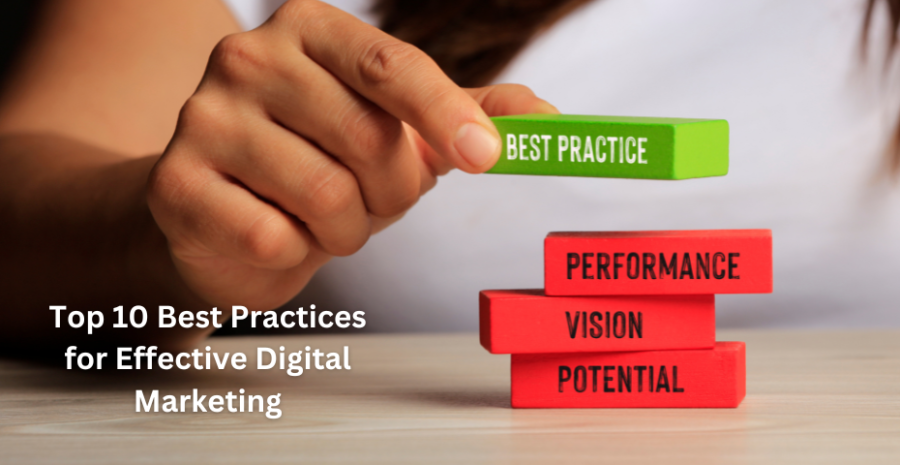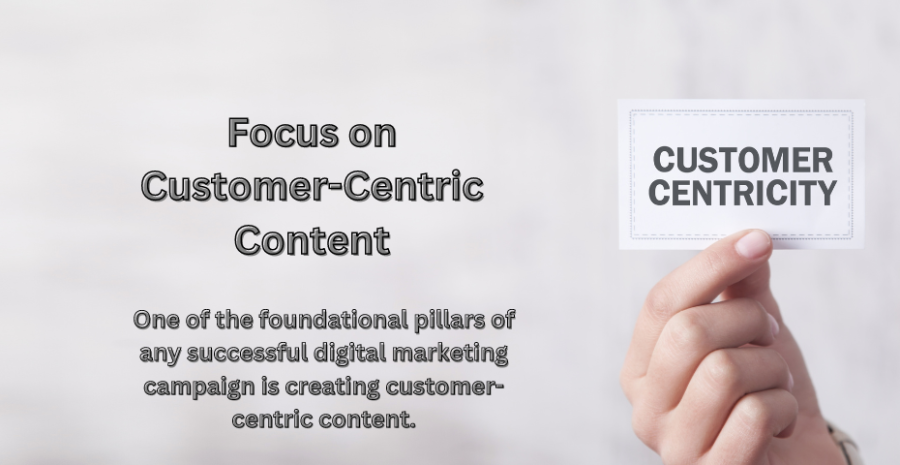
Top 10 Best Practices for Effective Digital Marketing

In today’s fast-paced digital landscape, mastering the art of digital marketing is no longer optional for businesses; it’s essential. The internet has become the primary medium through which businesses interact with customers, whether it’s via social media, search engines, or email campaigns.
As consumers shift their attention to digital platforms, the need for businesses to develop strong digital marketing strategies has grown exponentially. From small startups to multinational corporations, every business must have a robust online presence to stay competitive and relevant.
But simply being online isn’t enough. The key lies in how businesses can leverage digital platforms to attract, engage, and convert potential customers into loyal brand advocates. This requires a well-rounded approach, incorporating everything from content creation to data analysis.
A successful digital marketing strategy focuses on customer needs and industry trends, continuously evolving to meet new challenges.
In this blog, we will explore the top 10 best practices for effective digital marketing. These principles will help businesses not only survive but thrive in the ever-changing online world, driving growth, improving brand visibility, and enhancing customer engagement.

One of the foundational pillars of any successful digital marketing campaign is creating customer-centric content. Today’s consumers are savvy, selective, and often overwhelmed with a barrage of information from countless sources.
To cut through the noise, brands need to create content that is not only informative but also tailored to their audience's specific needs and preferences. This means diving deep into your target demographic, understanding their pain points, and crafting solutions that resonate with them.
Whether it's blog posts, social media updates, or email newsletters, content should be valuable, actionable, and engaging. The rise of personalized content has shown that businesses that focus on the needs of their audience, instead of just promoting their products, tend to build stronger connections.
It's also vital to ensure the content is optimized for SEO, making it easily discoverable by search engines. Content that addresses customer questions or provides insightful information will drive higher engagement, build trust, and ultimately lead to better conversion rates.

Data is one of the most powerful tools in digital marketing. Businesses have access to an unprecedented amount of information about their customers—what they like, what they purchase, where they spend time online, and more.
Utilizing data-driven insights allows businesses to make informed decisions and fine-tune their marketing efforts to increase effectiveness. This involves using tools like Google Analytics, CRM platforms, and other marketing software to track performance metrics, understand customer behavior, and measure the success of campaigns.
With accurate data, marketers can identify which strategies are working and which are not, enabling them to adjust their tactics in real-time. Additionally, predictive analytics can help anticipate future trends, allowing businesses to stay ahead of the curve.
Whether it’s segmenting email lists for targeted campaigns or using A/B testing to improve ad performance, data-driven marketing helps businesses maximize ROI.

In today’s connected world, consumers expect to interact with brands across multiple platforms. Whether they’re scrolling through Instagram, checking their email, or browsing a website, they want a seamless experience.
Omnichannel marketing integrates all of a business's digital touchpoints, providing a cohesive and consistent message across platforms. This approach ensures that whether a customer is interacting with a brand on social media, in an email, or via the company’s website, they receive a uniform and engaging experience.
The goal is to create a unified customer journey that enhances brand perception and loyalty. For instance, a customer who receives a promotional email should be able to easily navigate to the website or social media page for more information, without encountering barriers or inconsistent messaging.
Companies that adopt an omnichannel approach report higher engagement and customer retention rates, as they meet the audience wherever they are.

With mobile devices now accounting for a majority of internet traffic, mobile optimization has become non-negotiable for businesses. Consumers are using their smartphones and tablets to browse, shop, and engage with content more than ever before.
As a result, businesses must ensure their websites and marketing campaigns are fully optimized for mobile users. This includes having a responsive website design that adjusts to different screen sizes, as well as ensuring that content loads quickly and is easily navigable on smaller devices.
Mobile-friendly email designs and ads are also crucial, as these channels are frequently accessed via mobile devices. Google’s search algorithms now prioritize mobile-optimized websites, meaning businesses that don’t cater to mobile users risk falling in search rankings.
By providing a smooth, fast, and intuitive mobile experience, companies can increase user satisfaction, reduce bounce rates, and improve their overall digital presence.

Video content has rapidly become one of the most effective tools in digital marketing. Studies show that video content captures attention faster and retains it longer than text-based content.
Platforms like YouTube, TikTok, and Instagram have capitalized on the power of video to engage users.
Businesses should leverage video marketing by creating diverse types of video content—explainer videos, product demos, testimonials, or live streams.
Video marketing allows for creativity and storytelling, helping businesses connect with their audience on a more emotional level.
Furthermore, videos are highly shareable, which can increase brand exposure. Incorporating video into social media posts, landing pages, and email marketing campaigns can significantly enhance engagement rates and improve conversion.
.png)
SEO remains a cornerstone of digital marketing. In a world where billions of searches are made every day, ensuring your business appears at the top of search engine results is critical.
Effective SEO goes beyond just using the right keywords. It involves optimizing website speed, creating high-quality backlinks, ensuring a mobile-friendly experience, and consistently producing valuable, relevant content.
Businesses should also focus on local SEO, especially if they operate in specific geographic areas, to appear in local search results. Google’s algorithm is constantly evolving, making it necessary to stay up-to-date with the latest SEO practices.
Businesses that master SEO can drive organic traffic, increase visibility, and ultimately grow their customer base without relying solely on paid advertising.
.png)
While organic traffic is essential, businesses can’t overlook the power of paid advertising in accelerating digital marketing efforts. Platforms like Google Ads, Facebook Ads, and Instagram Ads offer highly targeted ad campaigns that allow businesses to reach specific demographics based on age, interests, location, and behavior.
Paid advertising can help generate immediate visibility, drive traffic to websites, and promote products or services to a larger audience. The key to successful paid advertising lies in understanding your audience and crafting compelling ad copy and visuals that will capture attention and lead to conversions.
Furthermore, businesses should continually monitor their ad performance and make adjustments to improve their campaigns’ effectiveness over time.

As voice-activated devices like Amazon Alexa and Google Home become more popular, optimizing for voice search is becoming increasingly important. Voice search queries are often longer and more conversational than text searches, so businesses need to adjust their SEO strategies accordingly.
Voice search optimization focuses on answering questions in a concise, informative manner. This involves using natural language in content and creating FAQ sections on websites to target common voice search queries.
As more consumers rely on voice search for everything from finding local businesses to making online purchases, businesses that optimize for this trend will gain a competitive advantage.

Social media remains a powerful tool in digital marketing, offering businesses the opportunity to engage directly with their audience, build brand awareness, and foster a loyal customer base. However, success on social media requires more than just posting regularly.
Businesses should actively engage with their followers by responding to comments, answering questions, and participating in relevant conversations. Social media algorithms tend to favor posts that generate high engagement, so encouraging likes, shares, and comments can increase a brand's visibility.
Additionally, businesses should tailor their content to each platform, whether it’s creating visually appealing Instagram posts, sharing informative LinkedIn articles, or posting fun, interactive content on TikTok.

Digital marketing is a rapidly evolving field, and what works today may not work tomorrow. The best digital marketers are those who continuously test their strategies and adapt to new trends and technologies.
Whether it's experimenting with new ad formats, tweaking email subject lines, or trying out a new social media platform, testing is essential for discovering what resonates with your audience. Split testing, or A/B testing, can provide valuable insights into what elements of a campaign are driving results.
By regularly analyzing performance data and staying open to change, businesses can stay ahead of the competition and continuously improve their marketing efforts.
In the world of digital marketing, standing still is not an option. Businesses must consistently innovate, adapt, and embrace new trends and technologies to stay competitive. The top 10 practices outlined above provide a comprehensive approach to building a successful digital marketing strategy.
By focusing on customer-centric content, leveraging data insights, embracing omnichannel marketing, and prioritizing mobile optimization, businesses can create more meaningful interactions with their audience.
Incorporating video content, mastering SEO, investing in paid advertising, optimizing for voice search, and actively engaging on social media are also critical steps in enhancing digital marketing efforts. Most importantly, businesses must be prepared to test and adapt their strategies in response to the ever-changing digital landscape.
In doing so, they not only increase their chances of success but also position themselves as leaders in their industries.
These digital marketing practices will remain pivotal in helping businesses thrive in a competitive and constantly evolving marketplace.
.png)
About: Andries vanTonder
45 years selfemployed
He is a Serial Entrepreneur, an Enthusiastic supporter of Blockchain Technology and a Cryptocurrency Investor
Find me: Markethive Profile Page | My Twitter Account | My Instagram Acount | and my Facebook Profile.
